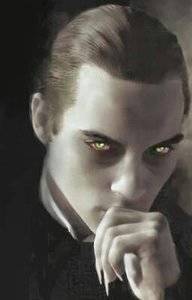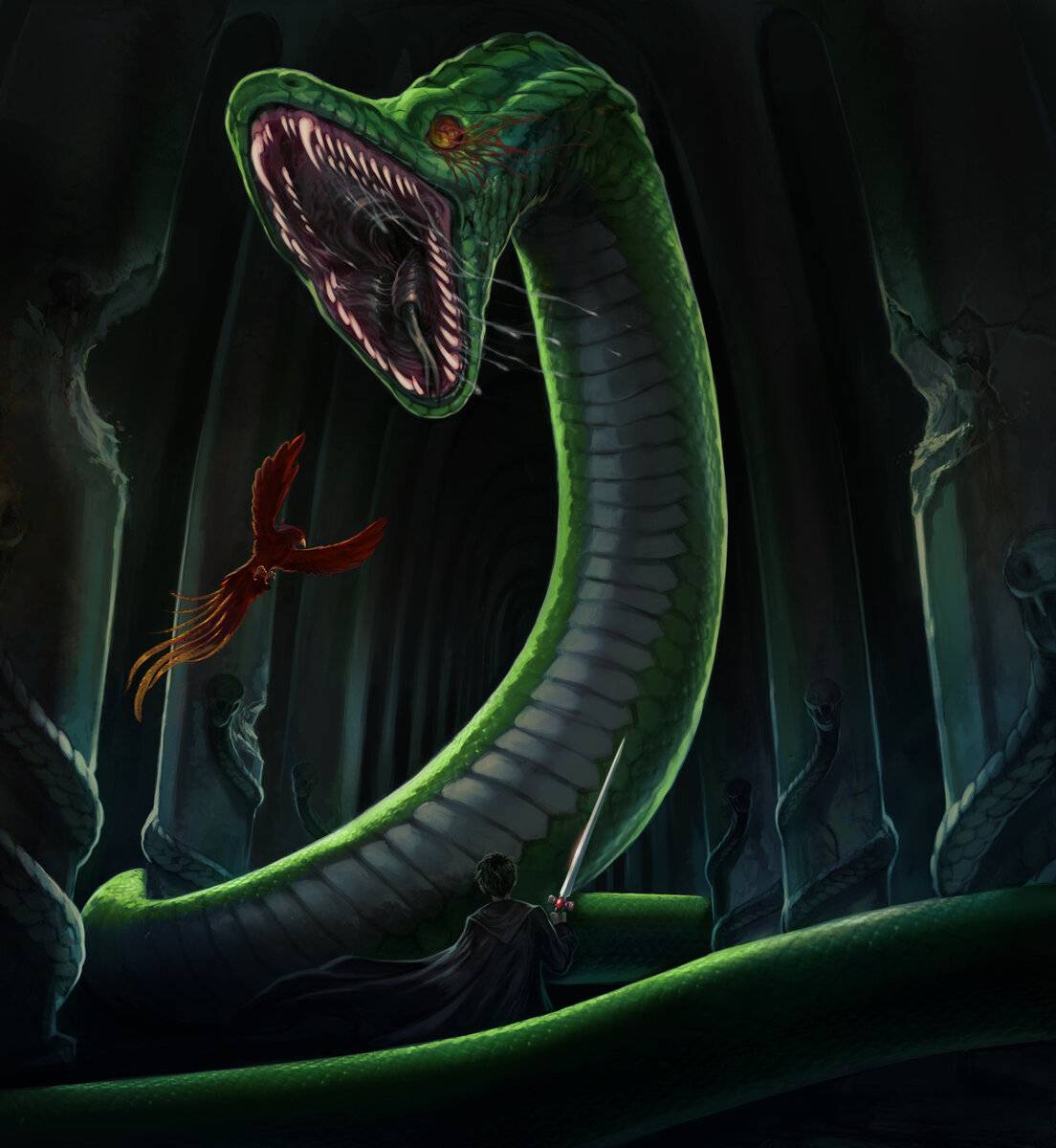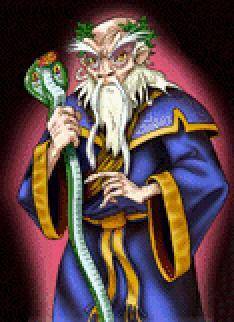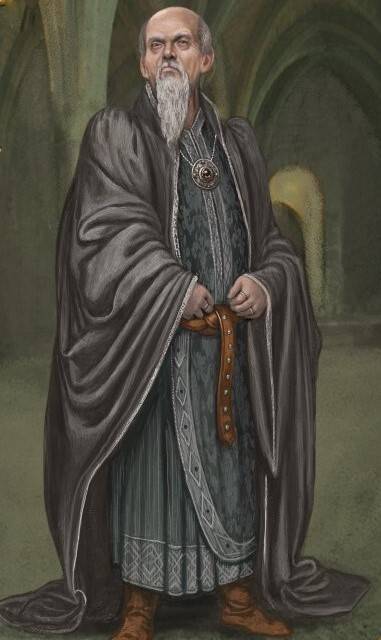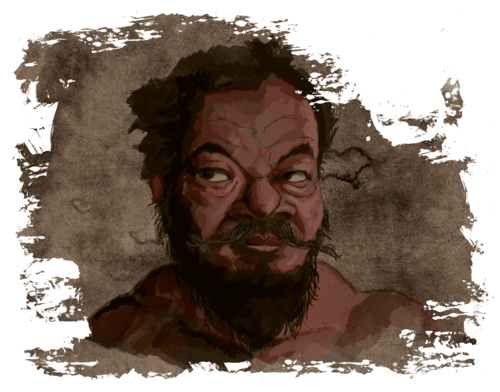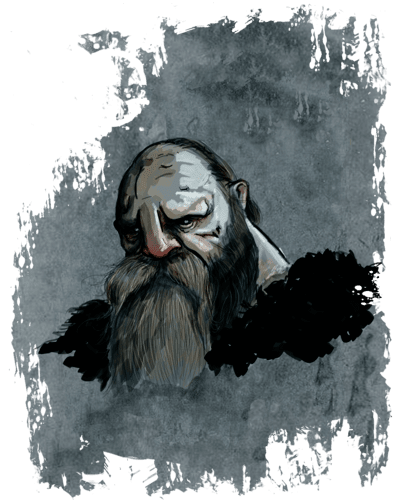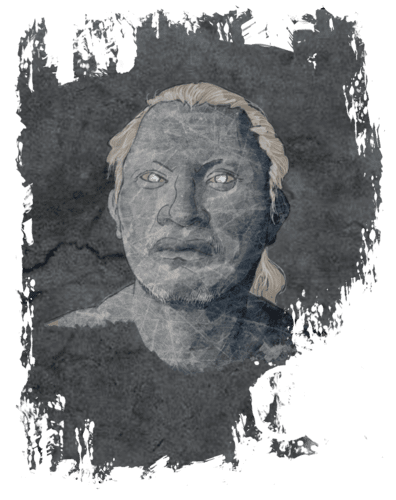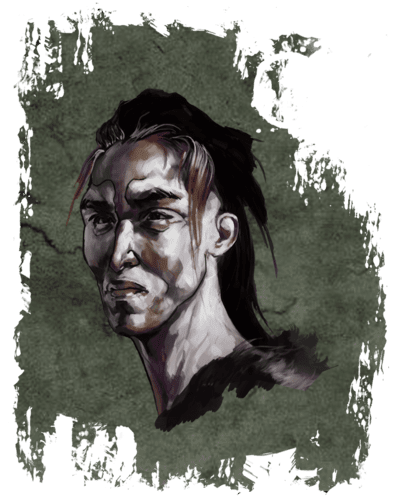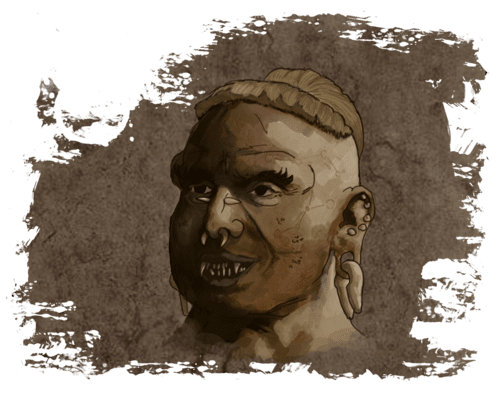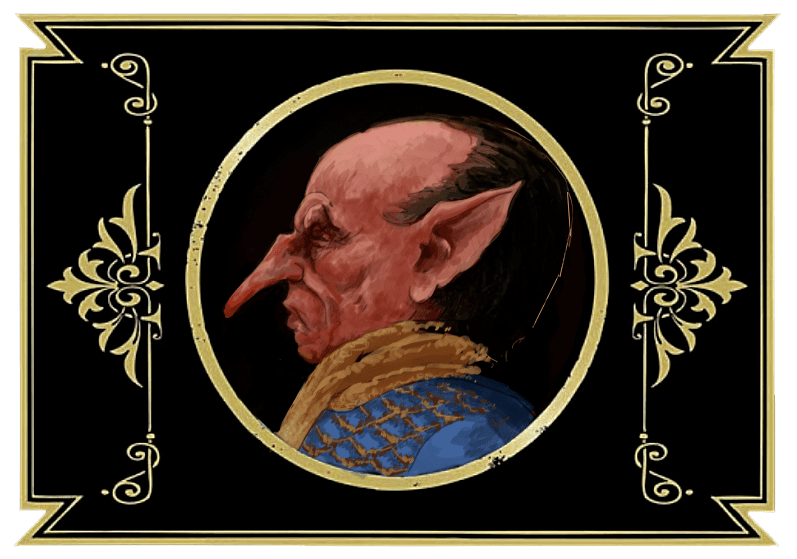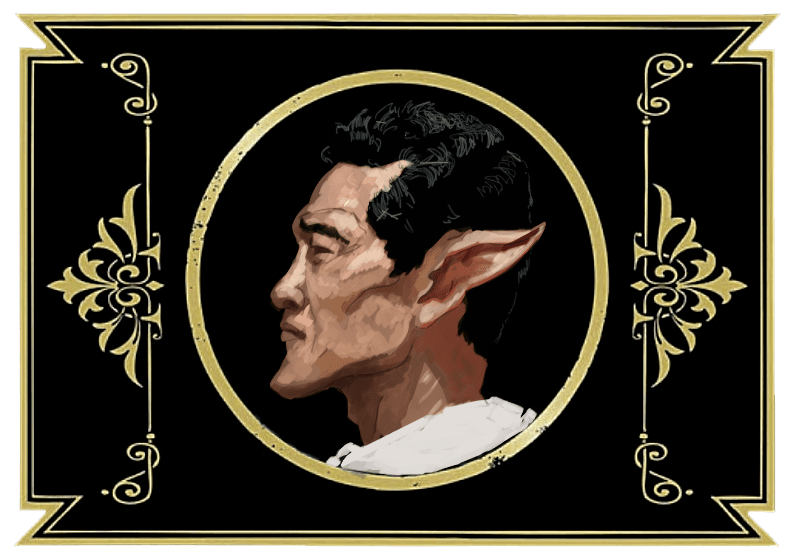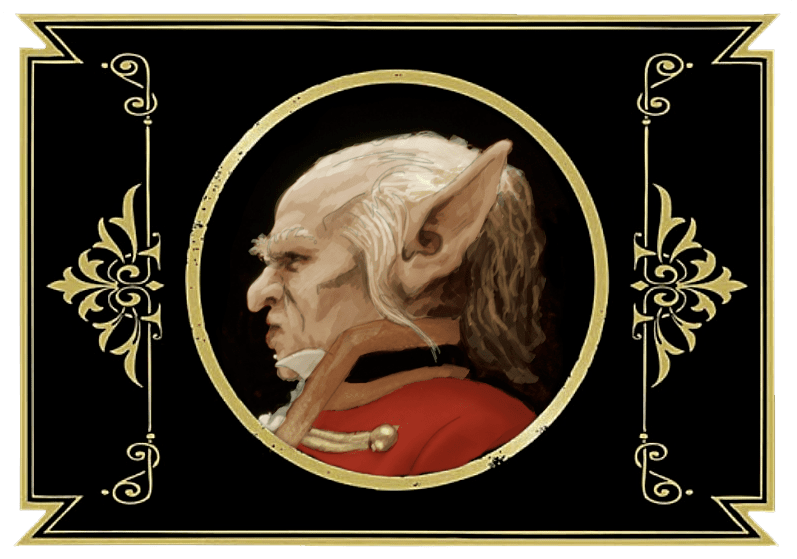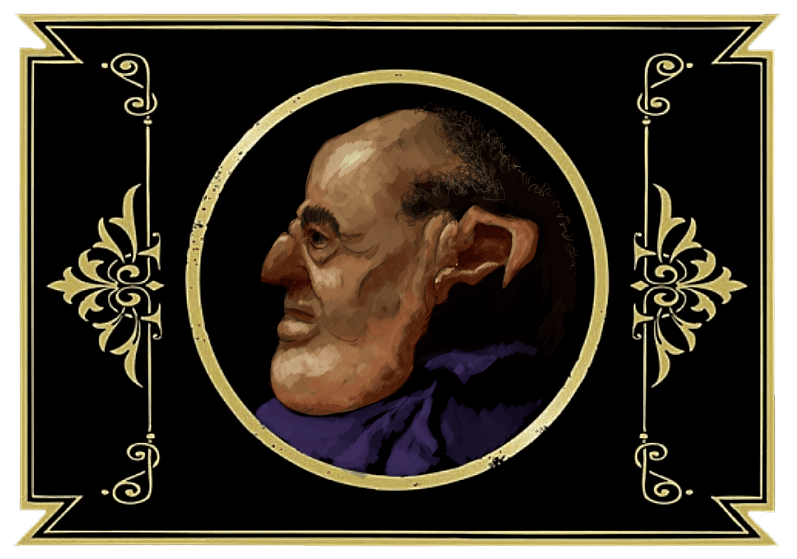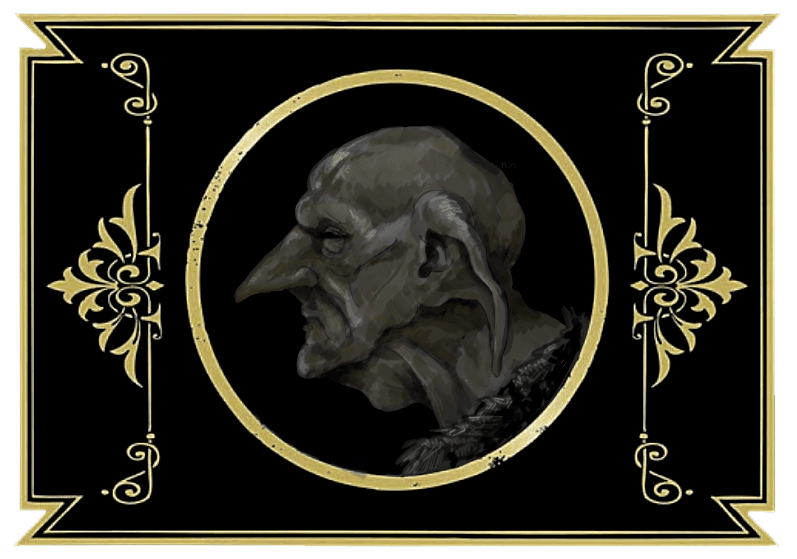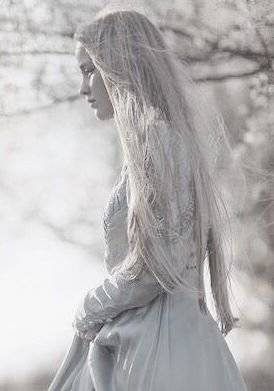Beings of the Wizarding World
That was the definition written for who qualified as a "being" by Minister of Magic Grogan Stump back in 1811. In this way, he redefined the way many wizarding people looked at several species living among them. Many years later, and a lot of problems still remain. But the definition was never altered again. While some species refused the being status, such as the centaurs and the merpeople, the others haven't experienced much equality from it either."Any creature that has sufficient intelligence to understand the laws of the magical community and to bear part of the responsibility in shaping those laws"
Below you'll find a collection of lore on most of the beings you will encounter around the wizarding world. Buckle in, it will be quite the ride.
Index:
- The Dhampir
- Vampires
- Parselmouth
- Part-Giants
- Giants
- Part-Goblins
- Goblins
- Seers
- Part-Veela
- Werewolves
- Muggles
- Hags
- Metamorphmagi
- Merfolk
- Centaurs
This is the "Game Master" account. Please do not owl this account, unless specified. This account is not moderated actively and therefore, you may not receive a response.
Contact a Head of House or the Headmaster if you need anything.
Beings of the Wizarding World
The Dhampir
OverviewWhile not much is known about vampiric lore, dhampirs (also referred to as half-vampires, half-beings, or half-humans) are even more obscure. There has been one definite, recorded case of a dhampir living on British soil, this being Lorcan D’Eath (b. 1964). Nothing more is known about the singer, however, as he refuses to share information on how his status as a half-being came to be. It was long speculated that dhampirs are not born, but this has recently proven to be untrue. However, it is rather far more common for dhampirs to be the result of a failed Turning (as the ritual of creating a new vampire is referred as) where the ritual of creating a new vampire instead results in the victim entering a sort of half-state that is neither there nor here, neither human nor vampire. 1
Appearance:
- Retractable Fangs
- Stronger, sharper fingernails than human
- Pale
Classification: Half-Breed
Native Range: Anywhere close to human civilization
Mortality: Mortal
Average Lifespan: Unconfirmed (assumedly similar to the average lifespan of a witch or wizard)
Abilities:
- Faster movement
- Increased strength
- Able to consume both blood and solid food
- Aura of Unsettling
Weaknesses: Aversion to sunlight
Dhampirs would therefore exist in certain gradients with some appearing more human while others show more vampiric characteristics.
Dhampirs are unique in the way that they are both capable of consuming human blood as well as solid foods, yet it is believed that unlike with vampires, dhampirs are heavily influenced by the type of blood they consume. It is speculated that when feeding off of unwilling victims, the human soul of the dhampir is damaged and the dhampir suffers in losses of sanity and human morals. Whether or not this damage is reversible is yet to be ascertained.
While vampires have sturdy, sharp fangs similar to the ones a predatory animal might possess, dhampirs have noticeable gaps where the canines are located. Hidden in the gums are a set of retractable fangs that extend during states of heightened emotions (such as anger or fear), and extreme hunger. A starving dhampir, no matter if they consume blood or solid foods, will display their fangs like a full-blooded vampire might do.
North American studies show that the fangs of a dhampir develop in two stages. The first, juvenile set of fangs that a dhampir develops during childhood are inferior to the longer, sharper, and more durable set of fangs that grow in once a dhampir reaches maturity. The fully matured fangs, however, are still an averagely half an inch shorter than the fangs of a full-blooded vampire.
On first glance, a dhampir might pass for a normal witch or wizard, yet upon closer inspection, they will usually display an unnatural paleness that one might associate with certain human illnesses or severe exhaustion. Dhampirs are usually stronger and faster than the average human, yet are far inferior to the speed and strength of a vampire. Their fingernails are stronger and sharper than a human’s and grow at increased speed. They are assumed to be primarily used as a means of self-defense rather than actual weapons.
Dhampirs display a certain weakness to sunlight, their movement growing sluggish under prolonged exposure. Their skin will burn in a similar way of a human sunburn, which can be treated in similar ways through tonics or potions.
Studies from Romania have stated that some dhampirs shed bloody tears when crying, although the reason behind this is still unclear. Some assume that the state of a dhampir's soul might be attributed to it. This claim however, while interesting, has yet to be proven with actual case studies.
Dhampirs are, like other half-beings, usually regarded with disdain from both sides (namely vampiric and wizarding) and do not appear to be associating with the same social groups as vampires in British Magical Society. It is therefore deduced that any attempt to connect to vampiric social circles will be met with distrust and maybe even outright hostility.
1It is here that the author would like to note that there have been recorded cases of people claiming to be dhampirs, born to a vampire and a human parent, recently these claims have been found to be true. Until further studies can be made on this subject, the author would like to point out that while uncommon, a naturally born dhampir is a possibility.written by Alma Malvado
Dhampir's eyes can be any color, however, the most common eye color is red or grey. Whatever eye color a dhampir has will often change to an inky black color due to their expanding black pupils in the dark. It is believed that the over-consumption of blood might cause a dhampir to descend into madness. It is not known how much blood over what period of time must be consumed to cause this.
Last edited by AngelFyre McCubbin on 31 Jan 2024, 06:31, edited 1 time in total.
Reason: Edited spelling of dhampire/s to dhampir/s throughout.
This is the "Game Master" account. Please do not owl this account, unless specified. This account is not moderated actively and therefore, you may not receive a response.
Contact a Head of House or the Headmaster if you need anything.
Beings of the Wizarding World
Vampires
Studies on vampires are, due to the lack of willing subjects as well as general prejudice against creatures in Wizarding Britain, few and far in between. Thus many aspects of vampiric life are yet to be definitely confirmed. The following text therefore is the result of what few studies and observations there have been made of vampires, as well as whatever information has been given by vampires themselves.Overview
Appearance:
- Dark Eyes
- Pale Skin
- Fangs
Classification: Beings
Native Range:
- North- and South America
- Africa
- Europe
- Asia
- Australia
Mortality: (assumedly) mortal
Average lifespan: 170 - 200 years
Abilities:
- “Resistance” to physical
damage (depending on age and health
of the vampire)- Faster than human reaction time
- Faster than human movement
Weaknesses:
- Garlic
- Sunlight
Although vampires are also referred to as ‘creatures’ in this text, they’ve officially been classified as ‘beings’ by the British Ministry of Magic.
What is known
The common vampire is a usually tall, humanoid creature with sharp fangs and seemingly dead, pale skin. Although many of them appear to be hairless, there have been many instances where vampires appeared with a full head of hair and even beards (Vlad Dracul being the earliest and most well-known example of this). Although they may appear frail at times, they hold superior strength to the average witch or wizard and are able to physically overwhelm a person with fair ease.This usually holds true even when the vampire is starved or injured.
Vampires are creatures of darkness, unable to walk under the sunlight, both direct and indirect, without their skin blistering and burning. Prolonged direct contact with sunlight will prove fatal to vampires. Other than that, vampires can survive many administered wounds that would be fatal for a normal wizard, suffering less consequences from blood loss or shock. To heal, an injured vampire will consume a larger amount of blood than usual for the being before retreating to a safe location to rest until recovered. Despite their status as ‘beings’, they are prohibited from seeking medical aid in wizarding hospitals and it is thus unknown just how healing spells and potions affect vampires.
History
Vampires are considered undead creatures and are believed to be the creation from old branches of necromantic magic.
They cannot survive without regular consumption of blood and although they consume both magic and mundane blood, it is unknown how different types of blood might affect a vampire and sustain their bodies for a longer period of time. The older the vampire, the less frequent they have to consume blood to sustain themselves.
To avoid blood frenzies (the state a starving vampire reaches when survival instinct and hunger overtake any sense of moral or reason the vampire might have), the Ministry hands out blood bags to registered vampires, containing donated muggle blood. There had been a long ongoing argument over using magical blood, yet the dangers of handing out such large amounts of blood for the vampire to use (or re-sell if they so choose) eventually resulted in the decision of simply purchasing non-magical blood from muggle hospitals.
Vampire blood is a ministry-controlled, highly volatile potion ingredient that may only be used by a witch or wizard with a mastery in potions or alchemy and that also possesses a legal, up-to-date permit. The illegal possession or redistribution of vampire blood is a punishable offence by up to 5 years in Azkaban.
Drinking vampire blood hold no positive effect for the average witch or wizard and have resulted in numerous side-effects, all of which were comparable to the result of drinking blood of dead or undead creatures.
Vampires have no special resistance to magic but also do not hold the same weakness to fire that other creatures that have been classified as undead, such as ghouls or inferi, display.
(Im)Mortality
Although a lot of myths exist concerning vampires and immortality, none of them could be either proven or disproven. Previously, there have been records of vampires dying of seemingly natural causes (see the records of Camillia Sanguina (1561 - 1757) for reference), yet it is unknown whether or not they died of illnesses, contaminated blood or even foul play.
The creation of a vampire is not something well-documented and vampires are not very forthcoming with the precise making of a new vampire. It is, however, known that vampires see this creation as a form of ritual and thus as sacred. We can therefore deduce that the procedure follows set actions and movements (similar as with rituals in the wizarding and muggle world), such as the giving and the taking of blood between vampire and human. The secularistic promise of salvation, which is so commonly found in mortal rituals, would in this case be the creation of a new vampire.
While vampires are under the jurisdiction of the British Ministry of Magic, it is believed that they themselves possess their own sets of laws and system of justice. Despite many attempts to discover more about vampiric culture, no data was obtained and it is believed that no wizard will be able to gain more information unless becoming a vampire themselves.
written by Alma Malvado
This is the "Game Master" account. Please do not owl this account, unless specified. This account is not moderated actively and therefore, you may not receive a response.
Contact a Head of House or the Headmaster if you need anything.
Beings of the Wizarding World
Parselmouth
"Hannah, he’s a Parselmouth. Everyone knows that’s the mark of a Dark Wizard. Have you ever heard of a decent one who could talk to snakes? They called Slytherin himself Serpent-tongue."
— Parseltongue's infamous reputation, Harry Potter and the Chamber of Secrets
Parceltongue was first discovered by Phillipus Aureolus Theophrastus Bombastus von Hohenheim, more commonly known as "Paracelsus," an honored scholar, wizard and physician. Parseltongue is the language of serpents, including magical snake-like creatures such as the Runespoor, Horned Serpent and Basilisk. An individual who can speak Parseltongue is known as a Parselmouth. Being a Parselmouth is a very uncommon hereditary skill thought to be exclusive to the Slytherin-Gaunt bloodlines.
Parseltongue is, when spoken, a hissing sound, that sounds similar to that of a snake. Normal people are not able to understand Parseltongue. The exception being Magical Multilingualists such as Dumbledore who can understand Parseltongue but they cannot fluently speak it or influence serpentine creatures with Parseltongue as they themselves are not a Parselmouth. In addition to communicating with serpentine lifeforms, Parselmouths are also able to influence the will of snake-like creatures. This was seen with Herpo the Foul's control over the Basilisk. Finally, Parselmouths can communicate with other Parselmouths in Parseltongue.
Famed Parselmouths
Herpo the Foul
"The first recorded Basilisk was bred by Herpo the Foul, a Greek Dark wizard and Parselmouth, who discovered after much experimentation that a chicken egg hatched beneath a toad would produce a gigantic serpent possessed of extraordinarily dangerous powers."
—Newt Scamander, Fantastic Beasts and Where to Find Them
Salazar Slytherin, the first known Parselmouth was
Herpo the Foul. Herpo the Foul was an infamous Ancient
Greek Dark Wizard who was the first known wizard to
create a Basilisk as well as the first known Horcrux.
Being a Parselmouth, Herpo the Foul was able to
communicate with and control a Basilisk and he
terrorized his ancient community with his dark magic,
curses and power over a Basilisk. Herpo the Foul was
also a pioneer in the field of Dark Arts, inventing many
vile curses that are still recognized to this day. Due to
Herpo the Foul's darker contributions to the magical society, Parselmouths have since been reputed as "evil" by many
or a sign of being a "dark wizard."
Salazar Slytherin
"We’ll teach just those whose ancestry’s purest."
—Slytherin's opinion regarding the running of Hogwarts
Hogwarts. Salazar Slytherin was a pure-blood wizard
noted for his cunning and determination. He was
regarded as one of the greatest wizards of the age. In addition to being a Parselmouth he was a skilled
Legilimens.
Salazar Slytherin is remembered for his mistrust and
disdain for Muggle-born students, he famously
proposed that muggle-born students should not be
accepted at Hogwarts. This notion was not shared by
the other Hogwarts founders. In response, Salazar
Slytherin left the school, never to return. Slytherin
died sometime during the eleventh century, after creating
the Chamber of Secrets, concealing a basilisk, with the
intention of purging the school of those who in
Slytherin's view, were unworthy to study magic.
Tom RiddleFamed dark wizard and graduate from Hogwarts, Tom Riddle was later and better known as Lord Voldemort. The most wicked wizard of the modern age, Lord Voldemort was a known Parselmouth, dark magician, maker of several Horcruxes, murderer, skilled Occlumens and Legilimens. He is credited with ending the Gaunt bloodline, by framing Morfin Gaunt, last of his line, for the murder of the Riddle family (also by Voldemort) who later died in prison. The Gaunt bloodline being the last branch of descendants that could claim direct ancestry from Salazar Slytherin, the existence of Parsemouths today is evidence that the trait did not die with the Slytherin family line.
Lord Voldemort is remembered for his beliefs in blood purity, despite his own half-blood heritage. Voldemort claimed that Muggle-borns were actually Muggles who stole magic from real wizards and witches, rather than actually inheriting it rightfully, and so deserved to be severely punished for it. His charisma was instrumental in Voldemort's growing following of Death Eaters and his own rise to power. Voldemort was ultimately killed in 1998 by Harry Potter.Isolt SayreNot all Parselmouths left a dark legacy. An exception being Isolt Sayre, co-founder of the Ilvermorny School of Magic in Mount Greylock, Massachusetts. Isolt did not share in the elitist ideals and opinions of her pure-blooded Gaunt and Slytherin ancestors, she married a muggle and co-founded this American magical school which is celebrated to this day as one of the most accepting and least elitist wizarding schools in the magical world. Isolt has been a credit to magical society.
Birthing a squib as well as a magical daughter that refused to marry and carry on the Parselmouth trait as well as the potentially dark legacy such might share, this Parselmouth bloodline ended with one generation following Isolt.Present Day Parselmouths
The legacy of the Parselmouth's dark heritage has caused the trait to die in many families. An example would be Rionach Stewart, daughter of Isolt Sayre who to end the bloodline's potentially dark and miserable legacy chose to have no children. Another being the inbreeding of the Gaunt family to maintain their 'purity' which limited their numbers.
Generally Parselmouths are not looked upon fondly. Due to the dark magic ties Parselmouth has carried historically as well as the atrocities committed by some of its more famous bearers, it is not a surprise that the Parselmouth skill being found in other, even unrelated bloodlines is a source of fear and shame.
House GauntThe House of Gaunt was once a prominent, wealthy family in the wizarding world, and the once honored bloodline originated from many powerfully magical wizards and witches. However, they knew of Salazar Slytherin's secrets such as the Chamber of Secrets, were complicit in his plans to harm the 'unworthy', helped protect Salazar's secrets and were believers in pure-blood supremacy. Their family tree has narrow branches, they are known for marrying their cousins to keep their "bloodline pure" which did ultimately in part lead to their destruction as their numbers dwindled.
Their wealth and prestige was squandered generations ago, lack of foresight, thought and perhaps mental instability on the part of the wizards in possession of the family's means. The last bearers of the Gaunt name were killed and imprisoned by Lord Voldemort himself. The Gaunt name is extinct in the male line; extant in the female line. Meaning that there are some people to this day that may have a distant relation to Salazar Slytherin but they would not share the Slytherin or the Gaunt family name. As most wizards know their ancestry for several generations, it is unlikely that a Gaunt Parselmouth exists, even from an extant female line. Until the 20th century, the Gaunt line had been exclusively pure-blooded.Chamber of Secrets
"Reliable historical sources tell us this much. But these honest facts have been obscured by the fanciful legend of the Chamber of Secrets. The story goes that Slytherin had built a hidden chamber in the castle, of which the other founders knew nothing. Slytherin, according to the legend, sealed the Chamber of Secrets so that none would be able to open it until his own true heir arrived at the school. The heir alone would be able to unseal the Chamber of Secrets, unleash the horror within, and use it to purge the school of all who were unworthy to study magic."
—Cuthbert Binns on the legend of the Chamber of Secrets
The Chamber of Secrets was created under the Dungeons of Hogwarts School of Witchcraft and Wizardry during Medieval times by Salazar Slytherin. Salazar Slytherin bred and housed an ancient Basilisk which exceeded the expected lifespan of a Basilisk of 900 years within the chamber of Secrets.
There was a legend that the basilisk was intended to be used to purge the school of Muggle-born students. The Chamber was flanked with towering pillars that were entwined with carved wood, and the Statue of Salazar Slytherin was at the far end. The Basilisk resided within the mouth of Salazar Slytherin's Statue, which possibly symbolized Slytherin's ability to speak Parseltongue.
Only the Heir of Slytherin could allegedly open the Chamber of Secrets, through the use of Parseltongue. Over the centuries after Slytherin's death, many Headmasters conducted searches of the school to find the Chamber. None, however, were successful, and the Chamber was dismissed as a mere legend by many. When the Chamber was opened in 1943 and 1992, it was revealed to be real. Moreover, the ability to open the chamber is not limited to heirs of Slytherin but rather limited to those that possess the ability to speak Parseltongue.
Present Day Parselmouths
As most wizards know their ancestry for several generations, it is unlikely that a Gaunt Parselmouth exists, even from an extant female line. Until the 20th century, the Gaunt line had been exclusively pure-blooded. However, the Parselmouth bloodline predates Salazar Slytherin and likely also Herpo the Foul. While scholars have theorized that Salazar Slytherin shared ancestry with Herpo the foul as evidenced by Voldemort learning the secrets of Horcrux creation and the penchant and raw skill shared by many members of the family to learn, cast and develop dark magics, there is no proof of this. What can be said for certain, that since the death of Lord Voldemort and the passage of more than two decades, there has been a notable increase in Parselmouths seen throughout the magical world. While none have made it to North America, another supporting fact that it is likely that Herpo the Foul and Salazar Slytherin share a bloodline or a common ancestor, there has been a notable (yet small) upswing in Parselmouths seen in magical society. It is the presumption of some that these Parselmouths have always existed but that this trait has been kept a secret as a hidden source of shame for families but with an improved understanding of the world, these secrets have become harder to keep in the present day.
Parselmouths outside of the Slytherin-Gaunt bloodline are sparse, often being the first in several generations to develop, discover or at the very least admit to their ability to speak with snakes.
*Lore by Solomon Lear.
Last edited by AngelFyre McCubbin on 18 Oct 2024, 18:29, edited 1 time in total.
Reason: Corrected misspelling of "lecacy" to legacy under description of Isolt Sayre.
This is the "Game Master" account. Please do not owl this account, unless specified. This account is not moderated actively and therefore, you may not receive a response.
Contact a Head of House or the Headmaster if you need anything.
Beings of the Wizarding World
Part-Giants
Introduction
Half-giants, or more accurately part-giants, are magical beings with some giant blood. This can mean that they are indeed half human (wizard) and half giant, though most half-giants in fact are not direct children of giants but rather second or third generations of the offspring of the union between a giant and a human. As long as their giant relative does not date back over 4 generations, giant-like qualities can be retained and a person will be considered half-giant.
All known half-giants have had magical blood. They are able to produce magic to varying degrees, an ability that is assumed to have been inherited from their wizarding parent. It is unknown however, if a half-giant who has giant and muggle heritage would still be able to produce magic. Some scholars assume so based on the fact that giants themselves are magical beings, their magic supporting their massive body and indeed keeping them alive, while others argue that residue magic from giant heritage would not be enough to make the offspring of a muggle a wizard.
It is also unknown whether a muggle and giant are capable of having children together in the first place, as historically giants were far more likely to attack muggles than to develop the somewhat close relationship to them that could eventually produce a child.
Appearance
All part-giants will have some visible traits of their ancestors, mainly their tall build. Other physical characteristic show too, however, mostly in those who are closer related to the giants that founded their line. A skin color that diverges from the norm, long limbs, broad shoulders, much facial hair, squashed noses or long teeth may all appear in some half-giants, though not in all.
Certain character traits have a higher chance of being inherited by half-giants as well, notably a short temper, impatience or a predisposition towards violence. A part-giant may have none of those traits or all of them, though as they are at least half-human their behavior will only ever resemble that of giants, and never equal it.
There are part-giants who look almost fully human and will pass as tall wizards or witches, while others are not able to hide their gigantic heritage.
Sub-Groups
Notable half-giant populations were known to exist in four of the seven continents. Giants are or were native to: North America, South America, Europe and Asia. They differentiate not only in appearance but also in culture, with the popular depiction of giants by sources such as folklore affecting how they are treated by local residents.
Asia
Those close relationships between giants and humans in Asia lead to a higher number in Half-Giants and their considerably higher standing in society compared to other continents. They were recognized as warriors of immense strength or sometimes even as part-deities, making them valuable members of their respective communities. As such they started to develop their own culture, and at an unknown point began to invest in keeping their race alive and healthy by intermarrying to keep the giant blood strong in their bloodlines. Despite the slow dying out of their giant ancestors their number remain stable in present days due to this mixing of half-Giant blood among themselves.
Europe
Either by their own doing or the betrayal of humans, giants are generally feared in Europe. These days the wizarding communities rather keep the large folk to a distance and prefer to let them roam free in a limited mountain range, away from any major muggle or wizarding settlement. This has led to relations between humans and giants to have become very estranged and hostile. Their offspring are held to the same regard. Half-giants who tread amongst their fellow wizards and witches may often be approached with dismay or disgust by the remaining pureblood families. They are seen as large brutes, lacking in intelligence and poise. Though the occasional muggleborn may simply be at awe towards their larger fellow wizards and witches, it does not change the fact that these half-breeds are mostly avoided in the current European culture.
North America
There was never any love lost between giants and humans in the North American continent. All the giants the native population ever encountered where ones who considered them something between food and an enemy to fight over food with. The two species rarely got close without bloodshed involved and so it is no wonder that half-giants were always a rarity. Despite never being outright shunned from society, especially in the last centuries perception towards them has been largely filled with negative stereotypes. Having a part-giant child wasn’t as much of a sin as having children with a No-Maj, but they were still far from accepted. In general a half-giant is said to be a brute who lacks intelligence, good for a fist fight but not to be trusted when handling magic.
South America
Their status as god-like beings made giants almost revered in Southern America, and this high esteem was transferred to their half-giant children, not at least because they many times also had royal ancestry. It made them confident in themselves in their abilities, but also arrogant enough to think they wouldn’t need them. After the Spanish invasion and the vanishing of the giants only few of them remained behind however, their descendants intermarrying at times to keep some gigantic appearance and prestige in the family lines. There are just a few of them left, however, and their influence on the magical community is dwindling.
*written by Caradoc Browne & Elaine Pendrast
This is the "Game Master" account. Please do not owl this account, unless specified. This account is not moderated actively and therefore, you may not receive a response.
Contact a Head of House or the Headmaster if you need anything.
Beings of the Wizarding World
Giants
General Information
Giants are magical Beings that have an overly large, human-sized appearance. Their resemblance to humans varies between groups: some can look almost human while others only roughly resemble humans, some are very hairy, and some may even have bestial features such as sharp molars. They can reach a height of up to 25 feet or 7.5 meters and have a lifespan that is longer than that of the average witch or wizard.
Giants live in groups or tribes that are usually ruled by the strongest member of the group. Their numbers however have been declining for centuries due to both muggles advancing into their habitats and wizards hunting them, either for sport, out of fear or to protect the International Statute of Secrecy. This has resulted in most of the remaining giants coming together to form one large tribe that offers them better protection against other races.
In general giants are less intelligent than humans, but they speak their own language and are capable of learning how to write and speak other languages. They are also able to understand the workings of magic and have shown fondness for displays of magic if they are not used against them. Their hobbies include rock-throwing contests.
Most giants do not have the patience for longer discussions and therefore are easily distracted from a topic and prone to violent reactions if they are bored or don’t understand what is going on around them. This makes them dangerous for other creatures - magical or not - as giants are extremely powerful and possess a raw strength that reflects their enormous size. Furthermore their skin is highly resistant to all kinds of magic, bouncing off any spells cast at them, an ability that Half-Giants can also possess to various degrees.
Habitat
As far as modern wizards understand giants are native to four of the seven continents, those being the Americas, Europe and Asia. Today they are assumed to be almost extinct in both North and South America, though the odd rumor about giant sightings in the far north of Canada or the Andes will reappear every decade or so. No giants live on the African continent anymore, which is attributed to a lack of available food sources as well as a generally unfavorable climate in most of Africa. Contrary to this there exists a large clan of giants known to live in the Ural Mountains and various small groups inhabit northern Asia and the Himalayan region. In general all current giant habitats are located in areas that are not or only very sparsely populated by both muggles and wizardfolk. The current largest clan in the Ural mountains is ruled by what the giants call their "Gurg", a title meant for the strongest amongst them as being the strongest is considered a right to rule for them. This also means that the title is often contested by any other ambitious giants and often leads to infighting. Yet another cause for their dwindling numbers.
Asia
In mainland Asia, giants were seen as the strongest of fighters with an indomitable spirit and it is known that their interaction with both muggles and wizards was usually more peaceful than belligerent. Giants were revered warriors and not seldom involved in human wars, gaining glory and gratitude by either defeating foreign armies or aiding the locals in dire times such as floods and draughts. They were considered divine beings in ancient India and gods in the Korean countries of old.
The Chinese held giants in high esteem for their fighting spirit, and there are many well-known stories of giants who fought bravely for their land or emperor. These giants served in armies or helped the common people to protect themselves from such things as natural disasters. They were noted for often having short tempers however, quite a few giants embarking on pointless quests or destroying entire landscapes in their rage.
Japan’s main island of Honshu is the only of the japanese islands where the existence of giants was proven, though the last of them went extinct sometime around the 11th or 12th century. Research suggests that these giants migrated to the island while there was still a land connection between Japan and the Asian main continent, effectively trapping the local population once the Korea Strait had been fully formed. They were hunted both by muggles and wizardfolk however, and their relatively low numbers compared to their hunters eventually lead to their extinction.
Giant bones, or more precise skeletons, were popular among Japanese witches and wizards for many centuries, as they were often used in magical rituals to create enchanted, semi-sentient warrior ghosts which both participated in battles and were used to scare muggles away from magical places.
Nothing else is known about those giants, neither their size nor appearance. Muggle folktales depict them as huge and dark-skinned but curiously there are no wizard sources available on the species – this is stark contrast to China and Korea, where a lot of illustrations of giants can be found both throughout muggle and wizarding history. The giants indigenous to the Eastern Asian mainland had darker, tanned skin, black hair that they often wore long and beards in case of the males. They resembled humans more closely than any other giants, but were notably more muscular and had longer limbs. Their nails were often depicted as sharp and pointed. Unlike humans their usual dress consisted of loincloths made of leather, cloth or even leaves.
It should be noted that this provides something of a contrast to the giants native to the regions south of the Himalaya, mainly modern day India and Pakistan. Their skin is of a light blue or grey hue, and their looks in general are more beast-like than those of their eastern relatives. They also possess dark hair, though no beards, but longer sets of canines and beast-like claws and talons instead of nails.
Europe
Many tales exist of large figures who would walk amongst muggle and wizardkind, all across Europe’s history, from warbands in the north to craftsmen in the south and even settlements to the east. While the number of these giants has certainly plummeted, their legends are woven through many European cultures. Their renown as warriors is perhaps their most well-known trait, but with this comes a bloody past. Even to this day, European giants are a race to be considered highly dangerous and are therefore feared all across the continent, their short tempers and indomitable rage taking the lives of many, muggle and wizard alike.
Near and around the mountainous regions of the Balkan Peninsula, giants used to roam the lands, pillaging entire areas for food and survival. These people were known as the Ispolin. Described as big-headed and grotesque-looking brutes, they are by far the ugliest amongst their brethren. Their already hideous faces are usually adorned by many scars of fighting dragons native to the region. They were generally the largest of their kin, the enormous heads showcasing a broad jawline, heavy brow and small round nose that were distinctive to their branch.
A little ways south to their borders, there lived their distant cousins the “Elini” or Helenes (referring to their Greek habitat), a small group of spread out giants more notably seen as shepherds. Due to the historically covered fact of a one-eyed giant who was slain by the Greek hero, Odysseus., there is a common misconception that this giant belonged to a separate race called a “Cyclops”.
A more successful warband than those found in the Balkan would have been the Fomorians. This vast army had quickly conquered the isle of Ireland, killing the initial Irish settlers that lived there. It was said they had come from the sea and after two centuries of having occupied the land, were driven back that way. When the third wave of human settlers arrived, a large conflict arose between the two sides. After several years of war, only a single ship of giants survived and escaped towards open sea. These would not be the only tales of giants known to have crossed vast regions of water.
One such tale would recount Benandonner, a Scottish giant from the Isle of Man, who would sail one ship with each of his feet. Others, such as his opponent Fionn MacCool, had instead built a bridge between his land and a Scottish isle across the Irish sea. The start of this bridge is to this day known as the Giant’s Causeway. It should be noted that the giants roaming the British isles were similar in appearance to humans in shape, their size being their most obvious difference.
Upon the western European mainland several similar giants pop up in the old legends, both malicious and benevolent. Some would be feared as gruesome generals while others would even be recognised as saints in old religions. The giants of the isles and western Europe had a calmer shape to their faces than the others. They are described as “fairest” amongst the giants, though they still had hard features that put them apart from humankind. More pronounced eyeridges framed their slightly longer faces and large noses.
Far to the north, in the snow-white hills of Scandinavia, one particular race of giants would be the source of a large part of Norse mythology: the Jötunn, as they were known, would rule the frozen forests of the north. These ancient warriors had made themselves so infamously known that the Northern kingdoms spoke of “Jötunnheim” one of the nine realms held up by Yggdrasil, the world tree. In reality however, these people had made their residence high up in the mountains long ago, where they had built a stronghold and named it Utgard. When winter would break upon the land, these giants would come down from their fortress and pillage the many settlements below. Though if we are to believe the tales of old, there could occasionally be found a singular giant willing to reason with the mundane. Despite them having earned the moniker of “frost giants”, these people were not more resistant to the biting frost than any muggle or wizard. Therefore they wore many thick layers of heavy pelts across their bodies, the plethora of furs mixing in with their long beards and hair. Both the men and the women grew facial hair to fight the biting cold. Their small but bulky heads were often obscured by the amount of hair they hid under and their blocky noses were pressed hard into their faces.
Over the years the Jötunn have drawn back into secrecy. As luck would have it, a colony of trolls settled in the neighbourhood and overtime it was believed they were in fact the real frost giants. While an insult to their being, the giants used this misconception as a way of concealing their own presence in the mountains. With wizards starting to hunt down more and more giants over the years, this decision had proven most useful over time.
These days most giant colonies have died out, mostly due to their continued infighting, wizardhunts or war. It is said that the current largest colony in Europe has taken its residence up north in the Ural mountains, with mere pockets scattered across the rest of the world.
America
Giants are or were native to both American continents, though there is a gradual difference between North and South that can primarily be described by one factor: adaption. Far up in North America, extending onto the continent until the Great Lakes at the southernmost point, giants are associated and shaped by the element that rules this rough, often hostile climate: Ice. Countless native tribes have given these giants different names, but all their legends repeat the notion that their hearts are made of ice instead of flesh, their existence often attributed to a curse bestowed on them by witches or even gods.
Ice Giants are made of flesh and blood however, their bodies large with broad shoulders, light hair and snow-white, icy skin. The female Ice Giants are even bigger than the males, though besides that there they are hard to distinguish. Their race is notorious for eating humans, both muggle and wizard-kind, going so far as to hunt them in groups.
The aggressive behavior of Ice Giants towards humans was the prime reason they were hunted and driven back once muggles inhabited more and more of the land the giants were native to. They traveled farther north once their numbers started to dwindle, and if any are still extant they live far away from all human settlements, in the subarctic and tundra of Canada where the ground never defrosts and there are still wild animals for them to hunt.
The largest parts of North America have not been inhabited by Ice Giants however, but by a giant race the Native Americans called “White Giants” for their relatively fair skin. They were the younger and smaller relatives of the Ice Giants, tribes who had moved south in search of food and places to live and adapt to the local climate accordingly. Their smaller size, only up to 15 feet, made them less intimidating but also able to live on less food, and their more human appearance elicited less fear from the humans they lived alongside.
These giants wandered so far south as to what is today northern Mexico, spawning local myths and legends all along their way towards Middle America. They liked to settle on mountains and were noted for being rather intelligent as far as giants go, gaining proficiency both in building huts made of stone and mining their habitat for minerals and specific types of stone.
Folklore in the west of the US tells of another race, of man-eating giants with flaming red hair, who were at war with the human tribes around them. It is unclear whether that tribe existed however, as wizardfolk never found any proof of the existence of such giants.
One last race of giants lived in South America, high up in the Andes and all along the Western coastline of the continent. They too had come from another place, the legends of the indigenous people of old said, they had come after a great flood sailing ships and landed at the coast in small groups. North, their home had been, though where North was, nobody was able to say. Their blonde hair had set them apart and they’d been treated as gods or close enough.
They’d had a love for gold and developed a decent albeit clumsy grasp of the craftsmanship needed to manufacture trinkets and jewelry from it. They were incredibly strong, but not as tall as some of the other giant species and notably more patient than them. Unlike most other giants they’d had a close relationship with the humans who were their neighbours – so close that soon after the first half-giants had appeared in South America, children of unions of giants and royals of the Inka tribes.
The fathers and mothers of these children however had mostly vanished by the time the Spanish came to the continent, and to this day their continued existence remains nothing but myth. If some of them are still alive they live reclusive lives high up in the Andes Mountains, far away from prying human eyes.
*Lore by Caradoc Browne & Elaine Pendrast. Art by Caradoc Browne.
This is the "Game Master" account. Please do not owl this account, unless specified. This account is not moderated actively and therefore, you may not receive a response.
Contact a Head of House or the Headmaster if you need anything.
Beings of the Wizarding World
Part-Goblins
General Information
Half-goblins or part goblins are magical crossbreeds between humans (wizards/witches) and goblins. Over several generations (maximum 1/8 goblin blood) the half-goblins all inherit many features of a goblin. Half-goblins have magical blood in their veins like the other half-breeds, however, they do not inherit the special abilities goblins have such as creating galleons, magical multilingualism and an aptitude for wandless magic. What they do inherit is the high intelligence and unique magic resistance of goblins. In the past, all so-called half-breeds were under prejudice and half-goblins were included in that, but later a law had been passed down that discrimination against half-breeds would be an act of crime. There were well-known half-goblins who trained in the magical arts and even attended Hogwarts either as students or as professors. Unlike full goblins, they aren’t covered by the wand ban that forbade them from using wands. This is due to the wizard heritage in their blood. The Ministry keeps a close eye on these individuals however, as they often suspect spies within the part-goblin society.
It still remains unknown if it’s possible for a muggle to have children with a goblin and produce a half-goblin child. Although, historically, after the Statute of Secrecy was installed there were very few Muggles aware enough of goblins’ existence for this to be even remotely possible.
Culture
Half goblins are generally considered good-natured in a wizard’s eyes. They are for example accepted into most if not all magical schools. Their high intelligence often cause them to become great magical practitioners or excel in other professions that require high intellect. Their goblin heritage will however also cast them in a slightly negative light to some people. While perhaps not treated as badly as half-giants or werewolves, they are still considered second-rate citizens by many pureblood families.
Appearance
All half-goblins will inherit many traits from their goblin ancestors. The most obvious ones are their short height, long fingers and slightly pointed ears. But due to their other half from human, their hair and skin color are mostly normal and they have a friendlier looking human face. Unlike full goblins who have long pointy ears, half-goblins’ ears are only slightly pointy and still have a normal ear size like that of humans.
Sub-Groups
Goblins themselves have never become wide-spread across the globe in the centuries they have walked the earth. It comes as no surprise that their half-blood decendants haven't either. Depending on which part of the world a part-goblin is born in, they can live under very different circumstances.
Asia
Under the Tengu tribes it is highly forbidden to mix blood with any other race. Children of impure blood are to be cast out and will even be attacked on sight should they ever choose to return. Their goblin-parent will either be punished or cast out along with them depending on the tribe. Several young part-goblins of the Tengu tribes may feel hopeful that the arrival of a more "modern-thinking" king will eventually open the road back to their ancestral homes.
Generally a more accepting people, the Dokkaebi actually welcome any relative of theirs. Only a select few within the community pay attention to bloodline. However, most do accept half bloods in their midst and are willing to share their knowledge to any of their blood that is willing to listen. This open approach to life is reflected in their lifestyle of a strong alliance with their wizarding neighbours of which part-goblins are the most natural union between the two.
Europe
Very few part-goblins are seen across Europe for the very well-known reason that wizards and goblins are at war with each other there. Across centuries both parties have accused the other of being the instigator of this conflict. While there certainly have been ups and downs in this conflict, it is a clear reason for why there have been so little unions between a wand-wielder and a goblin.
Nevertheless, part-goblins are considered to be of wizarding heritage and therefor are allowed to wield a wand and be tutored in one of the world's magical schools. Because of the heavily critiqued ban on wand-wielding for goblins however, these part-goblin children are kept under close watch so they will not be found sharing wand secrets with their goblin relatives. Overall part-goblins in Europe are often prized for their quick and highly intelligent minds, which prove useful in the practise of spells.
America
The Muki have had, as far as anyone can tell, no half-blood offsprings with wizardkind. Either because of their far-off homes inside the deep-running mines in Southern-America or the extremely rare occurence for them to have time for intimate relations with other races, it is simply possible that no one has ever bothered to register a part-Muki descendant.
The mysterious Pukwudgie have a special connection to Ilvermorny School of Witchcraft and Wizardry. So special that they even became one of the house's symbols and still guard the school grounds to this very day. Whilst their bond with wizardkind can run deep, it has yet to be sealed in a union of lovers.
*Lore by Caradoc Browne & Griseldis Edelhardt.
This is the "Game Master" account. Please do not owl this account, unless specified. This account is not moderated actively and therefore, you may not receive a response.
Contact a Head of House or the Headmaster if you need anything.
Beings of the Wizarding World
Goblins
General Information
Goblins are a highly intelligent race of small magical humanoids that semi-coexist with the wizarding world. Their facial features are crude and often they are seen as grumpy by their mere appearance. A long and sharp nose extends from their sharp faces with pointed ears. They have small beady eyes sheltered under large brows, a natural evolved trait from their aversion to daylight. Long and pointy nails make their already prolonged fingers look even more harrowing, while a set of razor-sharp teeth brightens up their rarely seen smiles. A goblin's specific diet consists of meat, roots, and fungi. Goblins also converse in their own language, known as Gobbledegook, and are adept metalsmiths notable for their silverwork; they even mint coins for wizarding currency. A clear reference to them actually controlling the wizarding economy to a large extent.
Goblins have their own type of magic and are known to practition the arcane arts without the use of a wand. Though this is also a very large factor that seeps into their hatred for wizardkind as goblins are forbidden to study the intricate details of wandlore and the use of it. Throughout wizarding society they are represented by the Goblin Liaison Office of the Department for the Regulation and Control of Magical Creatures in the Ministry of Magic. Goblins are still considered to be inferior by many wizards, who foolishly believe that the goblins are comfortable with that arrangement.
Culture
Goblin society has been intertwined with violence and hate towards the wizarding community for centuries. Ever since Goblin king Ragnuk the First accused Godric Gryffindor of stealing the famous sword he had made for him, legend has been passed from generation to generation that wizards and witches were never to be trusted with precious “gifts” or money.
According to Goblin culture, an object’s creator is ultimately the owner of said object. Whereas a buyer has simply paid for a loan rather than the possession of an item. This ultimately different perspective has created a rift between Goblins and wizards. It has even been a known catalyst for several of their rebellions against their magical neighbors. While wands may not be an option open to them, they are however capable of performing great feats of magic. Goblins usually learn to control their magical abilties around the same age a wizard or witch would. Very different than the magical schools spread across the world however, goblins are often tutelaged under a master craftsman. Learning the deepest and darkest secrets surrounding the earthy elements and the process of smithing magical items. Even among wizards, a goblin-created item is often a highly valuable heirloom passed down from generation to generation, implying it's worth.
Throughout the years, wizards have usually held a superior stance towards Goblins and are seemingly unaware that the Goblins do not like that. Ironically, Goblins own much of the wizarding banking system, especially in Britain. This is due to their natural proficiency with silversmithing and minting coins. Gringotts, Britain’s most famous wizarding bank, was founded by a Goblin that went by the same name. While wizards quickly seized control of this institute, centuries later goblins were given ultimate control over it, along with the responsibility of protecting the wizarding currency – a matter that has great importance to both parties and may very well be their only point of agreement.
As the only wizarding bank across the world, Gringotts is quite different in their handling of coin compared to its muggle counterparts. Build in the 15th century by the goblin that gave his name to the company, Gringotts mainly serves as a heavily protected storage for wizards and goblins alike. Goblins thus both store and mint coins, giving the wizarding world but only one option in a well-known and safe place to store their money. Gringotts' main headquarters consists of a network of tunnels and caverns, a 100 miles underneath Britain's soil. Their vaults run up to thousands in number and the largest and oldest families' fortunes are kept within the deepest levels of the building. Magical wards, rumoured dragons and their famously and heavily valued nigh-indestructible metal reinforcements have kept the bank safe for centuries save for two known breaches in the 1990's.
On top of that, Goblins take business deals very seriously, even to the point were they will pursue a scammer until cornered or even start another rebellion over it. The last time a group of Goblins got scammed by being payed with leprechaun coins by Ludo Bagman, the Goblin Society refused to aid the wizards in their war with Lord Voldemort and chose to remain neutral in the conflict in retaliation.
Asia
A less popular variant of the more commonly known goblins on the British Isles, are the dark goblins, more commonly referred to as Tengu. A red-skinned variant, known for their feverish aggression towards any other than them. Legends speak of their ambushes with large golden sickles and they have been documented to feel more attracted to transfiguration magic, especially applying it to themselves in an attempt to become more fearsome.
These goblins have mainly settled themselves far into eastern Asia, mainly the Japanese Islands, but also China and other surrounding countries. Their rarely noticed villages have been reported to reference some sort of religion to an avian deity or at the very least an unanswered obsession with birdlike themes. This plays part in Tengu usually hiding their unusually long (even for a goblin) noses under birdmasks.
The Tengu were considered great hunters among their goblin siblings. Through the ages they have collected a vast knowledge on hunting and capturing all kinds of creatures both magical and non-magical. While considered somewhat crude in their way of life, the goblins of Gringotts have often relied on their relations with Tengu hunters for capturing and training magical creatures who would be utilised in the defense of their vaults.
By the 21st century, Tengu are one of the latest variants of goblins to open themselves up towards wizardkind and revealing their presence more openly. Rumors say they experienced a recent change in leadership, a curious and young goblin king.
A little down south you would be able to visit the Dokkaebi. Around the Korean landscape, hidden in small pockets of civilisation, these goblins have ingratiated themselves into the magical society through their commerce in magical items. These goblins are oddly often seen smiling and found in a festive mood. Though there are some who suspect this to be a mask they wear in public to hide their more malicious intentions. Regardless of their intent, they are to be considered great craftsmen. Even within the ranks of their goblin peers, their skill is praised for it's detail and power. It is from their design that the intricate and indestructible doors of Gringott's vaults were made.
Amongst other peculiar whispers surrounding these goblins, they are rumored to also be close to discovering the secret behind the western imported knowledge surrounding wands. At the very least there have been reports of magical clubs being used to showcase fascinating feats of magic.
Europe
The most infamous branch by far. While goblins in European wizarding society are still often considered as "second rate" citizens, they have also managed to integrate themselves heavily with their fellow magic users. The most popularly known fact on this subject would be the British goblins who currently hold the bank of Gringotts, and thereby heavily controlling the British (if not global) wizarding economy. While the bank was created by a goblin of the same name, it was very rapidly kept under wizard control. However four centuries later, 1865, the Ministry of Magic gave full control to the goblin management. While the reasons for this decision are left relatively obscured, many wizards and witches are not at all surprised given that this decision was made during Minister Spavin's tenure. A period under the longest serving minister of all time, marked by all kinds of contested changes.
These goblins are filled with resentment towards those very wizards that still deem them second class and do not adhere to their own understanding of a "gift". There is a century old understanding amongst these goblins that a gift is ultimately to return to its creator. They value their craft above all and even view their most skilled craftsman as their "king". While this title's significance has surely dwindled throughout the ages, it is still holds tremendous respect within Western goblin socialization. Many kings and queens have been at the head of one or two goblin rebellions and as such are often seen as their slightly more idealistic leaders.
At the present the identity of the current British goblin queen is not often openly discussed. Only her skill in smithing and cunning intellect is complimented by all who wish to share any information with an outsider. She has no real reach outside the country, yet whispers of her skill have even reached the ears of the few European goblins that traveled overseas to America.
Many smaller branches of being and creatures alike are believed to have originated from the same ancestors of goblins. Beings such as Trows, Pucai, Domovoy, Hobgoblins and Brownies are found all across Europe with physical similarities to both goblins and house-elves alike. While there are certainly noticable similarities amongst all of them, their numbers have never been confirmed high enough to fully speak of civilisations between them.
America
Far out in the South American jungles there is a vast network of mining colonies hidden deep within the earth. This is where the Muki reside for as long as anyone remembers. These goblins are an old and hard working race, who value work above all. Whilst smithing is of interest inside Muki society, their interest lies more in the obtaining of rare materials. Their ambition in digging as far as possible in the earth has often led them on to darker paths, even causing them to enslave muggle and wizarding children in order to have them work alongside them in the mines. While these practices are no longer considered among the Muki goblins, they fully remember their past by honoring it in heavily detailed carvings throughout the mining tunnels.
With their centuries long interest in minerals and magical components, the Muki were actually the source of a long and slow process of evolution in researching the use of magical materials for the creation of goblin artefacts. Their findings are what made goblin artistry capable of rising in both fame and value.
Only around the cusp of the 19th century these goblins came to the surface to learn of their neighbours. Now, several trading posts exist across the jungles, where wizard traders are allowed to see their wares. While invitations into the mines are sparce, even the most curious of wizardfolk know to be weary when they decide to set foot inside these halls. They often brandish a big bush of hair either on their head or face. This has led them to sometimes be miscredited for dwarves from folklore tales.
The final branch are known as the Pukwudgie. An American Goblinoid variant, even to this day they remain clouded in mystery. The most notable tale that depicts a Pukwudgie is the origin story of Ilvermorny School of Witchcraft and Wizardry. The story mentions their proficiency with bow and arrow as well as their own branch of magic, similar to that of the European Goblins. While the Goblins in Britain are heavily integrated in Wizard society, the Pukwudgie are not at all in America’s Wizarding Society. they remain hidden and secluded, away from the influence and dramas of wizards and witches.
Their seclusion has led them to be the only Goblin variant to have never mixed with other races. Given their cultural habits and private appraoch to life, this will likely never happen.
*Lore by Caradoc Browne & Griseldis Edelhardt. Art by Caradoc Browne.
This is the "Game Master" account. Please do not owl this account, unless specified. This account is not moderated actively and therefore, you may not receive a response.
Contact a Head of House or the Headmaster if you need anything.
Beings of the Wizarding World
Seers
“We Seers have always been feared, always persecuted ... it is – alas – our fate.”- The fate of a Seer, Harry Potter and the Order of the PhoenixOverview
A Seer is a witch or wizard who is gifted with the ability to see into the future through prophetic visions. This ability appears extremely rarely in the magical population, as it is a recessive trait with the tendency to skip generations. Wizards who manifest this this trait are said to have the Sight, or to be possessed of the Inner Eye. Although there are many words to describe them, Seers have existed for millennia, with recorded incidents of Sight stretching back even to Ancient Greece.
Although prophetic visions are the most obvious trait of a Seer, there are a range of differences which separate them from the average wizard. The first signs of the Sight appear before the seer reaches the age of 13, although it is extremely difficult to detect at this stage. Children with the power of Sight experience brief flashes of intuition rather than full-fledged visions. They are often not aware that this is happening, believing that they are simply lucky or finding a mundane explanation for their altering of fate. True visions typically begin to appear around the age of 13 to 14.Visions
The power of the Sight is difficult to control and often unpredictable. A young Seer’s visions tend to strike at times beyond the Seer’s control. When a vision strikes, a Seer’s eyes will gloss over or turn completely white. During this time, they are blind to the mundane world – their Inner Eye has awakened, and each of their senses are pointed instead toward prophecy. The Seer will be immobilized as their body goes rigid. Facial features tend to go slack, and to the untrained observer it may appear as though they are about to have a seizure. Some Seers have reported experiencing visions but being unable to recall what was foreseen. Others may verbally describe their visions as they occur, acting as the mouthpiece of fate, although this is not common.
Visions are, contrary to popular belief, not an exact prediction of future events. The futures seen within visions are simply a potential version of events. Typically, an event seen within visions will occur if the current sequence of events goes on uninterrupted. Unfortunately, the interpretation of visions is often difficult, as they provide only a brief glimpse of the future. Seers who come to the wrong conclusions based on visions can often end up making things worse. Intervening in the course of fate can also cause observers to label the Seer as a fraud, as their own vision has been “disproved” by the intervention.Other Distinguishing Features
A fully developed Seer can also be identified by their distinct hair, which often turns white around the age of 17. By this age, a Seer may have honed their talents to the point where they can be better controlled. Their intuition is keen enough to guide them away from disaster frequently. A mature Seer can use their intuition and the power of prophecy to guide their own path, although some Seers still achieve little of note.Famed Seers in HistoryCassandra Vablatsky (1894- 1997)
A celebrated seer and the author of Unfogging the Future, a Divination textbook required at Hogwarts School of Witchcraft and Wizardry. Her married name was Trelawney and she had a great-great grandchild who inherited the gift of sight named Sybill Trelawney.Gellert Grindelwald (c. 1883 – March 1998)
Considered to be one of the most powerful and dangerous Dark Wizards of all time, second only to Lord Voldemort. Gellert Grindelwald was also a Seer, and was the only Seer in history who could retain awareness while seeing his visions. In addition, he created a skull-hookah device which enhanced his visions and allowed others to see them as well. He used the power of Sight to predict the Second World War, using his visions as well as his device to share these visions with his followers and rally them to his cause.Sybill Patricia Trelawney (b. 9 March, pre 1962)
A half-blood witch and professor of Divination at Hogwarts. The great-great-granddaughter of Cassandra Trelawney, who was also a Seer. Sybill Trelawney is most well known for her prophecy concerning Lord Voldemort’s return, predicting his return as well as the escape of Peter Pettigrew. She also participated in the Battle of Hogwarts, the final conflict of the Second Wizarding War, tending to the wounded and attacking Death Eaters with crystal balls. Professor Trelawney continued to teach Divination at Hogwarts until 2014, continuing her tradition of predicting the deaths of her students.Seers in Society
Much like with other forms of Divination, the career opportunities offered to skilled Seers are limited, although their abilities of foresight can be used to great success in any career. The Hall of Prophecy in the Department of Mysteries of the Ministry of Magic contains records of prophecies spoken by Seers, even ones not employed by the Ministry. Seers can also find work as Naming Seers, offering parents a fitting name for their child based on predictions of the child’s future, although this practice has fallen out of vogue in the British wizarding community.
Since the end of the Second Wizarding War, the number of Seers born has increased dramatically. Where once there would only be a handful in a generation, there are now many more, with over a dozen registered Seers identified at Hogwarts. Additionally, there have been more Muggle-born Seers identified – something which was once considered a virtual impossibility, considering the dependence on genetics in manifesting the trait.
Despite documented instances of Sight such as Grindelwald’s shared visions and Sybill Trelawney’s prediction of Lord Voldemort’s return, many view Seers with suspicion. This is not entirely unreasonable, as many wizards claim to possess the Sight to further their own agendas or attract attention. As a result, Seers tend to be viewed as frauds until their predictions are proven to be correct in hindsight.
In today's world, Seers are still misunderstood by most, and this lack of understanding can manifest in a variety of ways. Some Seers may find others doubting their ability to separate reality from fantasy, as their prophecies can be seen as delusion by non-believers. Others may find themselves at the opposite end of the spectrum - believers in Sight often seek out Seers to take advantage of their gifts for their own gain.
*Lore by Rosalind Kibitzer.
This is the "Game Master" account. Please do not owl this account, unless specified. This account is not moderated actively and therefore, you may not receive a response.
Contact a Head of House or the Headmaster if you need anything.
Beings of the Wizarding World
Part-Veela
Overview
Appearance:
- dependant on the human part
- usually bright skin
- usually white-blonde hair
Classification: Half-Breed
Mortality: Mortal
Abilities:
- Charming
- proficient with music
Half-veelas are the offspring, or the descendants of an offspring, of a Veela and a human male. Veela are a female-only race in the sense that there is no male Veela, which does not mean that they do not reproduce with males, only that the term Veela is limited to females only. The descendants of Veela and humans are labelled as half or part-Veela and always inherit some of the traits of their other-worldly ancestors, most notably their immense beauty. Depending on the strength of the Veela it can take up to 4 generations of intermarriage with humans for those qualities to diminish to the point where their heritage is no longer noticeable.
Veela or Vila are a race of magical beings originally native to the eastern parts of Europe and western Russia. They are renown for their extreme beauty and have the appearance of blonde, young women dressed in white robes who can bewitch any man with their song or dance. Their hair is golden to light blonde, their skin fair and their eyes green or blue in color, reflecting the lakes and forests Veela live in or close to.
They have a fondness for fighting, music and strong, handsome human men. This liking is usually how half-Veela are created, as quite a few men have fallen for the gorgeous Veela, though not all survived to tell the tale. Veela are known for their tempers and once enraged will turn into Harpy-liked creatures with beaked, bird-like heads while long wings burst from their shoulders. They are also able to launch balls of fire from their hands.
Pure-blooded Veela however are far more likely to reproduce with the males of their own kind. Vodyanoy, as they are called, have no obvious relation to Veela beyond their magical heritage, humanoid form and shared biosphere. They live in the lakes Veelas roam close to, but where Veela are renown for their beauty and youth Vodyanoy appear old, grotesque and unattractive to the human eye. Their hair is blue or green and long like their unkempt beards, their body is coated in black scales and algae and they possess a fish's tail.
The female offspring of a Veela and a Vodyanoy will always be a Veela, while the male will always be a Vodyanoy. This fact still puzzles researchers, who assume that this unique facet of biology has to do with the magic abilities shared by Veela and Vodyanoy. This is supported by the fact that children between Veela and humans are always half-Veela, no matter their sex.
Abilities:
Much like their Veela ancestors, Half-Veelas are beautiful in looks and thus have the ability to allure most of those who look at them, their usually inherent beautiful singing voice helping quite a bit. They are also said to be mesmerizing and especially graceful dancers, though not all half-Veela have shown to possess this ability.
From their wizarding side they inherit the talent to use precise, controlled magic with a wand that is unlike the natural, feral magic Veela are capable of. Half-Veelas are also said to be more reasonable than their pure-blooded ancestors, another trait that is attributed to their human side.
Half-Veelas tend to have features that look more birdlike when they get agitated, which is only a remnant of true Veela who are capable of transforming their whole body when sufficiently angry. Contrary to humans, the appearance of Half-Veelas does not usually match their age - this is less obvious when compared to witches and wizards and more so with muggles, who age considerably faster and die earlier than those with Veela and wizarding ancestry. However, this slow ageing does not actually affect their lifespan, as a half-Veela does not live any longer than a normal wizard or witch would.
History:
Veela have attracted humans with their beauty for centuries. Many a man has fallen for the elusive, other-worldly beauty of the Veela, and almost as many have come to regret it. Veela are magical beings, but they are not human in nature and have a certain strangeness that will register with all those who are not, or no longer, blinded by their shining physical form.
Few human males have gotten close enough to Veela to have meaningful interaction, and of those most were wizards. Their secluded nature means that it is extremely rare to find traces of them, and while they are fond of strong men they might tire of them as fast as their fascination built. Courting Veela is hard for those enthralled in their beauty, as their voice and dance have hypnotising qualities that make it hard to keep one's wits.
More likely than not, the star-struck wizard or muggle ends up enraging the Veela, and finds himself falling prey to their fire and claws. Those few who don't, who hold on to their minds and manage to bind a Veela to them - be it with keen wit, perseverance or through an impressive show of strength - are sometimes the cause of a half-Veela's birth.
Their magical beauty however has long made wizard folk suspicious of those with Veela ancestry. The Veela's ability to entrance and bewitch in mind, half-Veela have often been accused of forcing their will on the innocent, of casting their spell on others to manipulate them for personal gain. Distrust has long followed those with Veela heritage, especially those children born to a full-blooded Veela. At the same time however, there is a certain fascination wizard folk have with those half-Veela, for they admire their beauty and are by times envious of it and the illusion of youth it provides.
Like all so-called half-breeds, half-Veela have historically been met with contempt by those who value wizarding blood over all else. They have faced hatred for not being "pure of blood" because of their mixed heritage, though it is notable that this prejudice often will only hold so long, as quite a few pure-blooded families pride themselves on having some far-removed Veela ancestry in their bloodline. There is an allure to beauty that transcends social norms.
*Lore Béatrice Lydursdattir and Elaine Pendrast
This is the "Game Master" account. Please do not owl this account, unless specified. This account is not moderated actively and therefore, you may not receive a response.
Contact a Head of House or the Headmaster if you need anything.
